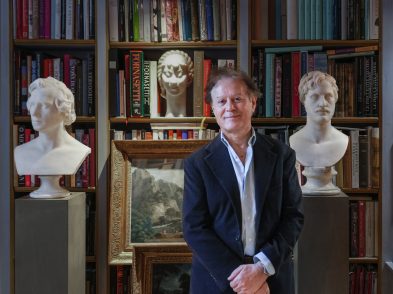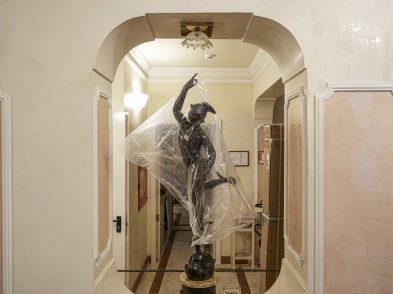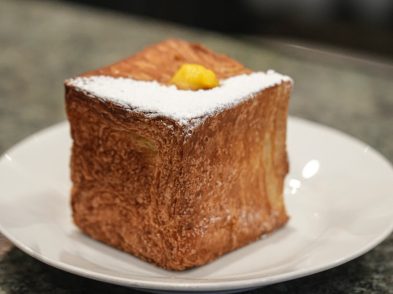Patricia Kinsella is the curator of the Prato Textile Museum’s current exhibit,
Superhuman Performance. A collection of over 80 garments, uniforms, kits and
accessories, the exhibition boasts sportswear from past and present champion athletes,
including Gino Bartali, Gustavo Thoeni, Valentino Rossi, Lance Armstrong,
Alberto Tomba, Kimi Raikkonen and more.
Originally from the United
States, Kinsella has spent the last 20
years in Prato as a textile designer and
instructor at schools in Florence, including SACI, Syracuse University, Polimoda, Fujistudio and
Fashion Institute of Technology. She sat down with us to chat about just how
inspirational textiles can be.
One of the best things about the Prato Textile Museum is that it takes a seemingly
unglamorous subject like textiles and makes it interesting. How does it manage
that?
Well, I’ve actually found that textiles can be a
jumping off point for arriving at any subject in
the world: economy, trade, politics, costume history, communications, sociology, psychology, chemistry, technology,
fashion, personalities, and so much more. The multifaceted aspect makes
it an incredibly exciting sector.
How did you get involved in the industry?
I got into it by accident in the
early 80s while living in Manhattan. My background is in art;
I have a master’s in fine art and a degree in textile arts. I moved to New York thanks to a National
Endowment for the Arts grant awarded to emerging artists. I wasn’t necessarily
looking for work in the textile sector-I had never even created a functional
textile before! But through a twist of fate I found myself working in a
loom-filled room in the garment district on my very first day in the city. My company,
a converter that designed apparel fabric for the US market had its fabrics woven all over the world;
one of our primary collaborators was a mill in Prato. I began travelling to the area for business
when I met my future husband. My plan was to stay in Italy for three months-that was in 1985!
What changes have you seen since then?
Everything is different.
I arrived in Prato just as the industry was
moving away from regenerated fabrics and was developing the image it has today:
an area where innovative fashion textiles are produced. Obviously, technology
has played a huge role in the changes that I’ve seen over the years. The
company that I worked for in New York doesn’t exist any more
because there is no need for it. Italian mills now work directly with garment
manufactures all over the world. Improved communications and business organization
has eliminated the need for
intermediaries.
In fact, one of the biggest challenges in teaching is showing my
students that although we are in the same industry, my work experience is totally
different from what they will encounter. Although the basics of creating fabric
are constant, the impact of globalization has had, and will continue to have, a
enormous impact on the textile business. The issue of sustainability in the
textile and fashion sectors is also a huge challenge for the future. My
students will not go down the same path that I did, so I try to teach them how
to find the answers for themselves by creating their own experiences and by
being curious and trusting in their creativity.
Speaking of creativity, how did you come up with
the idea behind Superhuman Performance?
I wasn’t interested in
doing a show that would somehow be a reiteration of all that I already knew-I
wanted to explore something that had piqued my curiosity, specifically how the
technology of fabric can impact physical performance. I thought about the power
that technology gives to athletes through fabric, but also about the power athletes
themselves give to the fabric by making us want to wear what they are wearing.
The show is filled with such amazing pieces. Was
it difficult to get access to such famous gear?
When I began thinking about the show, I started by making a huge
scrapbook with pictures of all of the athletes I wanted to include. When it
came time to begin organizing everything, I just got on the phone and started
cold calling each individual person, manufacturer, or representative.
Some were tough to get, but others were surprisingly easy-the whole
process was an adventure. I called Domenico Fioravanti on his cell and heard
splashing and cheering in the background-I found out that evening on the news
that he had been at a national swim meet!
When I called Celina Seghi, who lives in the area, she invited me to her
home, where she and her niece showed me to her trophy room, which was filled to
the ceiling with all of her awards and medals throughout the years. She brought
out all of her pictures and mementos from her glory days. It was incredible.
Each of the garments has something tangible, something magic in the
fabric itself.
Yet these athletes are not superheroes, but superhumans. What effect did the human
aspect have on you?
Looking at the suits,
you realize that we as humans are capable of so much. We have unlimited
potential. I think it is even more important to understand this during
difficult economic and social situations like the one we are facing in the
world right now.
To meet the
challenge head on, we really have to be our best selves. This is not a time for
complacency, but for strength. We have to get in shape, so to speak. Things are
hard everywhere and everyone needs to bring something great to the table. This
exhibition underscores that idea-you are confronted with individuals who did
fantastic things and reached amazing, unbelievable heights. It is a way to inspire us to ‘outdo’ ourselves in
a certain sense. You realize that we don’t need super powers-we just
need to be super.
For more
information on the Superhuman Performance exhibition at the Prato Textile Museum, visit www.museodeltessuto.it (in English).








